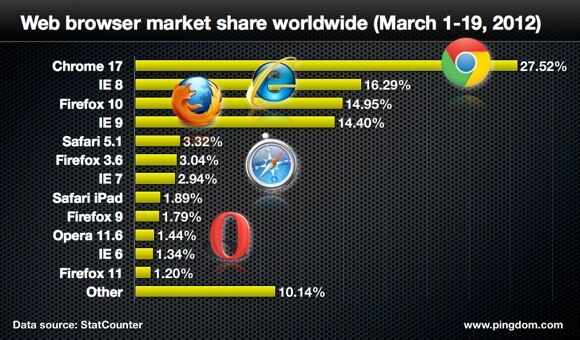 It was three years ago today (March 19, 2009) that Microsoft unleashed Internet Explorer (IE) 8. According to Microsoft, the priorities for IE 8 were security, compatibility, ease of use, web development improvements, as well as adhering to CSS specifications and other web standards.
It was three years ago today (March 19, 2009) that Microsoft unleashed Internet Explorer (IE) 8. According to Microsoft, the priorities for IE 8 were security, compatibility, ease of use, web development improvements, as well as adhering to CSS specifications and other web standards.
Three years on, IE 8 is still the second most used web browser version in the world.
Is that impressive or just simply sad? You tell us!
IE 8 still has over 16% market share
Microsoft released Internet Explorer 8 about two and a half years after IE 7 hit computers around the world. That’s half the time it took Microsoft to move from IE 6 to IE 7.
To put that in perspective, Google Chrome was at version 1.0.154 in March 2009. The current stable release of Chrome is 17.0.963.
But for a three-year old browser, IE 8 is really hanging in there. If we look at the latest statistics, IE 8 is still the second most used web browser version, with 16.29% market share, only behind Chrome 17 with 27.52%.

Other sources are in line with this, giving IE 8 a 17.53% share of the web browser market.
If we combine browser versions, IE is still number one with almost 35% market share, followed by Chrome close behind at almost 30%, and Firefox at around 25%.
Finally, IE 10 will get auto update
IE 10 is already out in a preview release and is expected in a final version together with Windows 8 later this year.
Of course the new browser will bring a slew of news and improvements, but most interesting is that it appears that IE 10 will get auto update functionality in the style of Google Chrome.
We’ve studied what effect the auto update feature of Chrome and Firefox have had on those browsers, and it’ll be interesting to see what happens with IE. Did you notice that there is no Chrome 16 or older in the chart above?
In fact, all the other versions of Chrome are bundles in that “other” category, each with a market share below 1%.
So as we say happy birthday (and good riddance!) to IE 8, we’re eager to say welcome to IE 10, and look forward to the continuing browser wars.



























